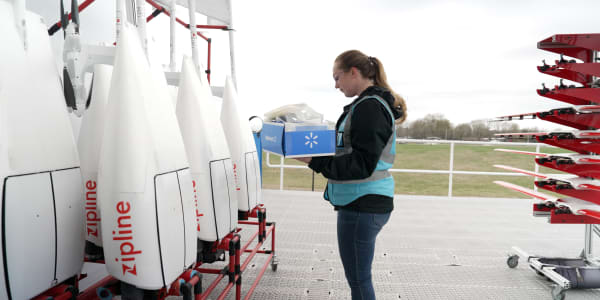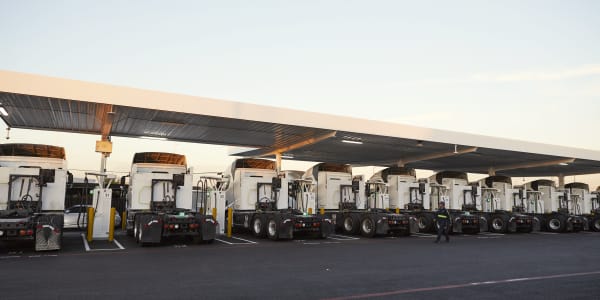To many observers, the endgame of Uber's auto market disruption is a world where you never own a car again.
But there's an irony in how Uber, (2016 CNBC Disruptor No.1), plans to get there: It's making a big push into the hundred-plus billion-dollar auto financing market.
Think about all the money that goes into leases and loans from captive financing units at Toyota, Honda and Ford, luring consumers into shiny new vehicles.
Automobile financing amounts to $116 billion a year just in the United States, according to IBISWorld, all for the sake of car ownership — or something resembling it.
Uber's mission is very different than that of a car company. It wants more Ubers on the road by any means necessary, and the newer the car, the better. After all, it's setting out to create the anti-taxi experience.
The company created Xchange Leasing last year as a wholly-owned Uber subsidiary. For a $250 deposit, an Uber driver can lease a new midsize or economy car, be it a Chevrolet Malibu, Honda Accord or Toyota Prius.
Add a monthly insurance payment, and drivers like Andrew Thornton are on their way.
"Where in America can you get into a brand-new car for $500?" said Thornton, 52, who leased a 2016 Hyundai Elantra in September. "My car was sick, and the transmission was slipping, and I needed a new car to Uber."
This at a time when Americans are paying more than ever for car payments. The latest data from Experian shows the average auto loan topped $30,000 in the first quarter for the first time. Auto loans topped $1 trillion for the first time ever during the first quarter, according to Experian, with increases in both the share of subprime borrowers and loans that are 30 days and 60 days delinquent.
Uber knows full well that for many people the Uber gig lasts just a few months. Owning a new car is not always feasible nor is it a priority. Here's the key: The car can be returned at any time with two weeks' notice, and the customer just loses the deposit with no further obligations.
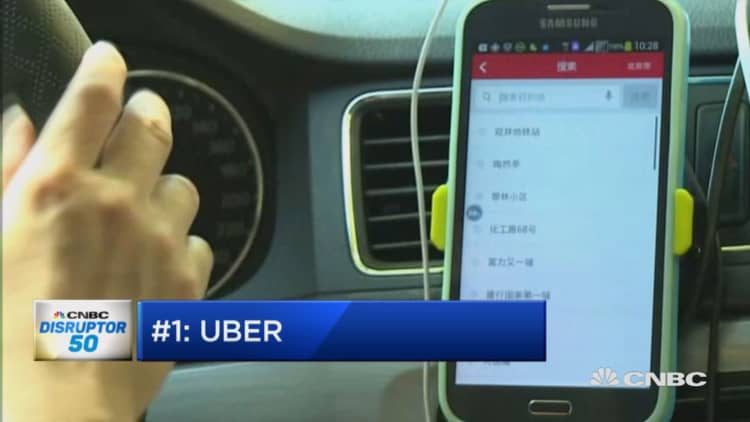
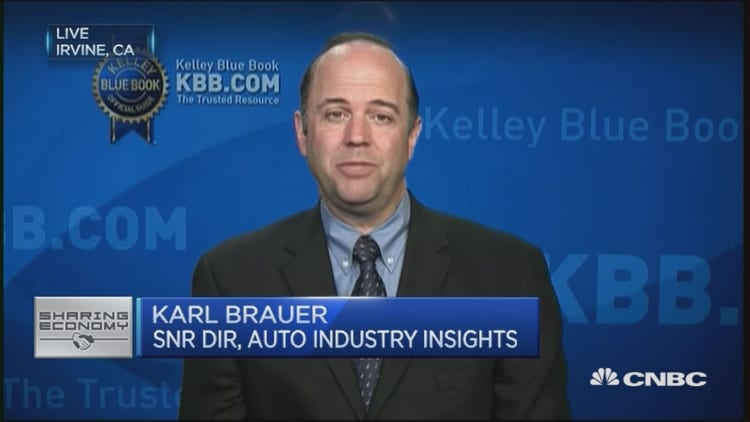
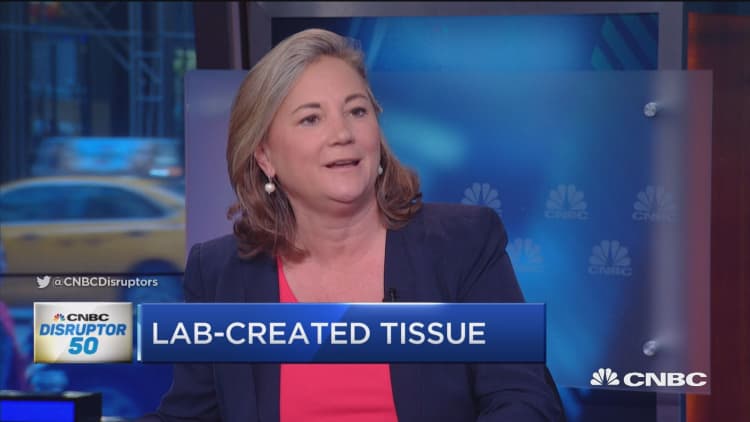
At a Chicago-area Nissan dealership, Xchange accounted for 41 percent of sales in May. In each of the first three months of the year, sales more than doubled from the same time in 2015, mostly because of Xchange deals, said a store executive, who asked that we not use his or her company's name.
Uber is "changing car ownership for drivers, with flexible options that allow people to get access to a car when they want to earn extra income," said Andrew Chapin, a former Goldman Sachs banker who now runs Uber's vehicle solutions group.
Chapin was managing operations at Uber in New York at a time when the company was exclusively a service for black cars. In his many conversations with drivers, he would frequently hear about the challenges they, their friends and family had getting financing for vehicles because so many were immigrants and lacked a credit history.
Chapin had some thoughts about what Uber could do. After he and Uber CEO and co-founder Travis Kalanick took a trip over to the New York Taxi and Limousine Commission in late 2012, Chapin ran a business idea by his boss.
Kalanick told him to go figure it out, so Chapin spent much of 2013 talking to carmakers, auto lenders and rental companies about the problem Uber wanted to help solve.
Xchange is one of several products Uber now offers. Another program lets drivers whose cars are in the shop get weekly rentals from Enterprise at a discounted rate and with unlimited miles.
And for those who want to own, Uber has deals with all the major manufacturers for fleet discounts typically of $1,000 to $5,000. In May, Toyota invested in Uber as part of a strategic deal that will include new leasing options through Toyota Financial Services.
Like the ride-sharing business, auto financing is a slog and requires country-specific solutions. In Singapore, Uber started a subsidiary rental company called Lion City Rentals, while in countries such as China, India and France, it's mostly working with third parties.
Financing cars by the thousands is hugely expensive. Xchange secured a $1 billion credit facility led by Goldman Sachs, according to a person familiar with the matter. The facility was put in place last week and includes capital from Citigroup, Deutsche Bank AG (New York Branch), JPMorgan, Morgan Stanley and SunTrust, the person said.
The credit facility was previously reported by Bloomberg News.
By the end of 2016, Uber expects that 100,000 cars will have been provided globally through the vehicle solutions programs, with $2 billion going toward car sales.
But of course, as with anything related to Uber, there's controversy.
Drivers approved for the program pay around $120 to $160 a week, and the money is deducted automatically from their earnings. At $600 a month or so for many drivers, that's a hefty lease, leading critics to claim that the terms are predatory.
Uber also continues to drop its ride prices, making it harder for some drivers to keep up.
Damian, a driver in Houston who asked that we not use his last name, had another story to tell. He leased a 2015 Ford Escape in late March at a rate of $162 a week.
Less than three weeks later, a catastrophic storm came through town, leading to extreme flooding and totaling his new car. He woke up at 5 a.m. the morning after the storm, and the Escape was half under water.
Uber's unbridled growth
Without a vehicle to drive, Damian couldn't make any money. He also couldn't get another car, because he still had the outstanding lease in his name while insurance matters were being worked out.
Worse, Xchange kept charging him every week even though there were no earnings available for withdrawal.
"I can't blame Uber for weather, but I wish they showed more compassion," said Damian, 31, who'd been working in construction prior to signing up with Uber. He's married with two kids, and his wife uses the only car they own for her job.
In mid-May, a month after the storm, Damian said he was finally released from his Xchange contract and was able to lease an Uber through another partner firm, named Bama Leasing.
You can call it growing pains for Uber as it quickly expands into new markets. But it's also the very real challenges that a Silicon Valley tech company faces in dealing with capital-intensive industries that have their own sudden and unexpected events, not always addressable with software.
Taking an 'Amazonian' approach
And just ask Damian how hard it is to reach an Uber customer-support representative by phone.
Uber's growth trajectory is unlike just about anything Silicon Valley has ever seen.
Founded in 2009, the company now sports a $62.5 billion private market valuation, a higher price than all but 10 U.S. tech businesses. Investors are placing a giant bet on Kalanick's ability to replicate his company's U.S. success in China and India while continuing to push the envelope with new products.
But as a private company, financial backers get very little visibility into how much these efforts cost and, even less, on future investments.
That level of transparency won't improve anytime soon. Kalanick told CNBC in March that he'll make sure an IPO happens "as late as possible."
Meanwhile, the company is quietly becoming a major player in the auto finance market.
At Stevens Creek Toyota in San Jose, Xchange accounts for 5 percent to 10 percent of monthly sales, said Ray Khandan, e-commerce director at the store. That's enough volume for Uber to have its own showroom.
Selling a brand-new car is only part of the deal. To avoid buying an overabundance of vehicles and sending many to auction after they get returned, Xchange has dealerships reassign cars to other Uber drivers when they get returned. It can be after a few weeks or a few months, and Xchange leases them to drivers with more troubled credit profiles.
There's no other way the model can work profitably for Uber.
"Today the largest cost for ride-sharing services like Uber is the salary of the driver, followed by vehicle depreciation," wrote Morgan Stanley auto analyst Adam Jonas in a report to clients last year. "Controlling the economics of depreciation mandates that such companies get closer to the used-car transaction."
Challenges ahead
For the dealership, the reassignment process doesn't bring any added economic benefit, but it's a requirement to be one of the eight to 10 sellers Uber partners with in a particular metro area. A car through Xchange also requires additional work.
The dealership installs a tracking device about the size of a mobile phone under the dashboard so that Xchange knows the vehicle's whereabouts. Khandan said they don't always work right, meaning Xchange can't track the car and his company doesn't get paid.
"Sometimes they get dislodged, have malfunctions afterward or, if the car is in a garage, it won't track," said Khandan. "If it's not working, we won't get the money until we get the car back and fix it."
These are minor problems for Uber in the grand scheme of things. After all, this is a company that's trying to change the face of driving across the globe.
Uber just raised an additional $3.5 billion from Saudi Arabia's Public Investment Fund. It's breaking fundraising records to fuel growth in China and an abundance of new products, all while fighting off regulators and incumbent taxi businesses in many cities around the world.
Oh, and it's also preparing for a future of autonomous driving.
Simon Rothman of venture firm Greylock Partners recently penned a blog post calling Uber the biggest winner in the "start-up steroid era" when investor cash was used as a "performance enhancing drug for company acceleration."
In his interview with CNBC, Kalanick said he takes an "Amazonian" approach to building Uber, referring to Jeff Bezos' tactics of constantly moving into new businesses.
It's a useful framework, considering Uber's aggressive push into auto leasing.
"I like to take our profits in some places and invest it in others," Kalanick said.










